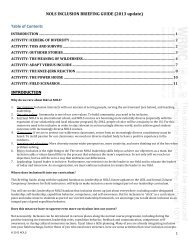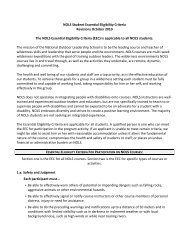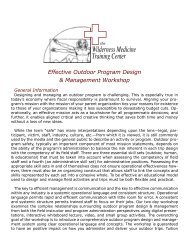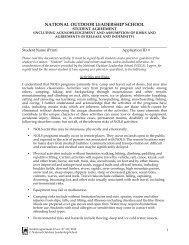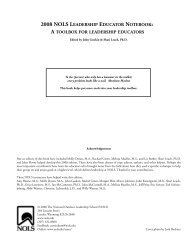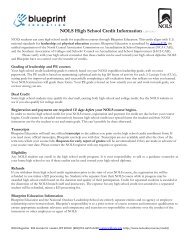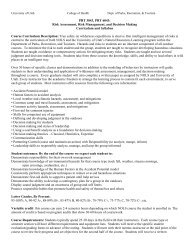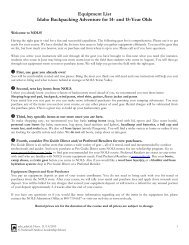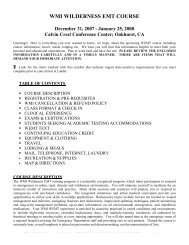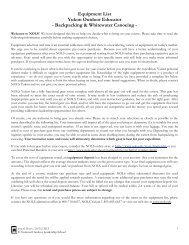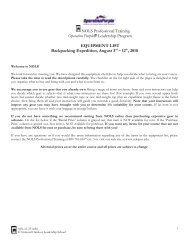Conference Proceedings Wilderness Risk Management - NOLS
Conference Proceedings Wilderness Risk Management - NOLS
Conference Proceedings Wilderness Risk Management - NOLS
Create successful ePaper yourself
Turn your PDF publications into a flip-book with our unique Google optimized e-Paper software.
This article may not be reproduced without the author's permission.Changing the QuestionFor years our industry has relied on the “Expert-Judgment Strategy” for dealing with questions of risk.“That one can always make a legitimate distinctionbetween ‘actual risk’ calculated by experts and so-called‘perceived risk’ postulated by laypersons.” (Shrader-Frechette 1990) The fact is, however, that environmentalrisk analysts have already concluded that “ALL risks areperceived”(Shrader-Frechette 1990)The result is that justDeveloping Skill SetsOperational risk management in adventure educationhas often been the attempt to quantify a finite set ofvariables-- Equipment, Environment, Human, etc.--tominimize the potential for loss. The fact is, however,that “Most people in the field of risk management oraccident investigation will agree that the human elementcomprises the largest portion of the accident equation”(Ajango 2000)One of the historical obstacles in trying tobecause we claim that a particular activity or understand the “human element” within formal riskenvironment is “safe” doesn’t make it so. Furthermore,the reliance on the “Expert-Judgment Strategy” byanalysis is the premise that people make rational choicesin the face of uncertainty.inexperienced staff members has real operationalconsequences. For example, if staff members are faced“Proponents of formal risk analysis tend to viewwith a decision in the field that falls outside of theiraffective responses to risk as irrational. Currenttraining or staff manual they are forced to rely on theirwisdom disputes this view. The rational and thedecision making skills. If their premise is “Is it safe?”they are really asking a highly contextual, highlyexperiential systems operate in parallel and eachseems to depend on the other for guidance. Studiessubjective question.<strong>Wilderness</strong> <strong>Risk</strong> <strong>Management</strong><strong>Conference</strong> <strong>Proceedings</strong>As Wilde points out in “Target<strong>Risk</strong>” everyone has his or her own internal level of“safe.”(Wilde 1994)Truthfully, however, the staff ismost likely asking the question “would my boss think ithave demonstrated that analytical reasoning cannotbe effective unless it is guided by emotion and affect.Rational decision making requires proper integrationof both modes of thought” (Slovic 2002).was safe?” Put another way, “Will I get in trouble forthis?” The obvious problem with this thinking is that itis relying on a fear-based decision making process toWhen we, or our clients, intentionally interact withuncertainty, we do so with a combination of affectivedeal with a typically ambiguous choice. If, however, we (emotional) and cognitive (intellectual) responses. It isremoved the “safe” premise and instead had the staff this complex group of factors that NASA has beenask “does this support what we are trying to help the pursuing in its “Human Factor Research.” It is theclient accomplish?” It stands to reason that the clientwishes to remain uninjured, so the “safe” question isstudy, among other things, about how human beingsmake critical decisions in the face of uncertainty.answered as a matter of course. More importantly,however, instead of reacting out of fear, we areempowering our staff to intentionally interact withuncertainty under expressed boundaries with a clear“There is no dearth of evidence in every day life that peopleapprehend reality in two fundamentally different ways, onevariously labeled intuitive, automatic, natural, nonverbal,defendable purpose. The role of the <strong>Risk</strong> Manager then narrative and experiential, and the other analytical,goes from being a person who punishes mistakes, or deliberative, verbal, and rational(Epstein 1994).”simply says no all of the time, to a person who developssystems, the staff, and the clients themselves to interact A major focus in Human Factor Research is the conceptwith uncertainty in a sustainable manner.of “Error <strong>Management</strong>”. This is based not on thepremise that people making decisions might make errors(mistakes), but that they will make errors. The result isthat teams are taught to highlight rather then hide the<strong>Wilderness</strong> <strong>Risk</strong> <strong>Management</strong> 2004 44
This article may not be reproduced without the author's permission.errors they make so they can identify and fix flaws in thesystem or flawed habits. In this way they become “selfcorrectingteams”. By focusing on Error <strong>Management</strong>skills sets, as part of both our staff training and programcurriculum, we begin including the clients in riskanalysis process while at the same time providing themwith important life skills.The Future of Adventure EducationIt very well could be that the reason people seekadventure education is not just for the physicalexperience but also for the skill sets that experienceprovides.The rate of change in this world, and theuncertainty that accompanies it, continues to accelerate;as a result the skill sets needed to navigate that changeReferencesare becoming increasingly important.<strong>Wilderness</strong> <strong>Risk</strong> <strong>Management</strong><strong>Conference</strong> <strong>Proceedings</strong>If we as anindustry were able to define, articulate and deliver thoseskill sets within an adventure education curriculum wewould be providing a critical service. In doing so wewould also have the definitive reply to those that wouldutilize the precautionary principle. While it is true thatthe potential for harm, injury and death will always existin adventure education, it is also true that the potentialfor harm, injury and death will continue to exist in everyday life. If, however, we are able to help people developthe skill sets for navigating uncertainty, we would notonly be reducing the “potential for loss” during ourprogram, but we would be reducing the “potential forloss” in every other part of ourclients’ lives.Ajango, D. (2000). Lessons learned : a guide to accident prevention and crisis response. Anchorage, Alaska, University ofAlaska Anchorage Alaska Outdoor and Experiential Education.Clare, J. (2004). Union tells teachers to end all school trips. telegraph.co.uk - Related by Outdoored.com.Cline, P. (2003). Re-examining the <strong>Risk</strong> Paradox. <strong>Wilderness</strong> <strong>Risk</strong> Managers <strong>Conference</strong>, <strong>NOLS</strong>.Cline, P. (2004). "The Etymology of <strong>Risk</strong>." (Submitted to publication in academic journal).Epstein, S. (1994). "Integration of the cognitive and the psychodynamic unconscious." American Psychologist 49: 709-724.Miles, J. C. and S. Priest (1990). Adventure education. State College, PA, Venture Publishing.News, R. s. E. H. (2000). Rachel's Environment & Health Weekly.Raffensperger, C. (1999). THE PRECAUTIONARY PRINCIPLE. Prepared for the NGO Biotechnology Briefing for WhiteHouse Officials.Shrader-Frechette, K. S. (1990). "Perceived <strong>Risk</strong>s Versus Actual <strong>Risk</strong>s: Managing Hazards Through Negotiation." <strong>Risk</strong>:Health, Safety & Environment Volume1: Pg.341.Slovic, P., Finucane, M. L., Peters, E., & MacGregor, D. G. (2002). "<strong>Risk</strong> as analysis and risk as feelings: Some thoughtsabout affect, reason, risk, and rationality." <strong>Risk</strong> Analysis.Wilde, G. J. S. (1994). Target risk : dealing with the danger of death, disease and damage in everyday decisions. Toronto,PDE Publications ; Castor & Columba.<strong>Wilderness</strong> <strong>Risk</strong> <strong>Management</strong> 2004 45




